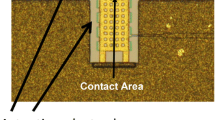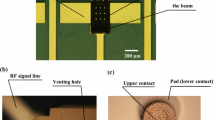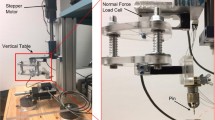Abstract
In RF-MEMS switches many reliability issues are related to the metal contacts in the switching area. The quality of this contact strongly influences switching failures due to wear, adhesion and stiction. Gold is widely used as contact material, but is a soft metal. Contact hardness can be improved preserving good conductivity and chemical inertness alternating gold layers with thin layers of other metals. A detailed study of mechanical, electrical and morphological properties of gold–chromium, gold–platinum and gold–palladium multilayers is presented and discussed. Annealing treatments modify hardness values, but a careful choice of the alloying metal is essential because hardness is reduced upon exposure to plasma ashing, a very frequent microfabrication process. This treatment also increases contact roughness, deteriorating the contact surface. Platinum is the only metal tested that is unaffected by plasma oxidation, and it also reduces the diffusion of chromium adhesion layer on the contact surface.






Similar content being viewed by others
References
Chen L, Lee H, Guo ZJ, McGruer NE, Gilbert KW, Leedy KD, Adams JJ (2007) Contact resistance study of noble metals and alloy films using a scanning probe microscope test station. J Appl Phys 102:074910
Coutu RA, Kladitis PE, Leedy KD, Crane RL (2004) Selecting metal alloy contact materials for MEMS switches. J Micromech Microeng 14:1157–1160
Dickrell DJ, Dugger MT (2007) Silicone oil contamination and electrical contact resistance degradation of low-force gold contacts. J Microelectromech Syst 16:24–28
Gregori G, Clarke DR (2006) The interrelation between adhesion, contact creep, and roughness on the life of gold contacts in radio-frequency microswitches. J Appl Phys 100:094904
Kwiatkowski R, Vladimirescu M, Zybura A, Bradic J (2004) High contact resistance readings on clean microwave mobile contacts. Proceedings 50th IEEE Holm Conference on Electrical Contacts, pp 160–167
Kwon H, Jang S–S, Park Y-H, Kim Y-D, Nam H-J, Joo Y-C (2008) Investigation of the electrical contact behaviors in Au-to-Au thin-film contacts for RF MEMS switches. J Micromech Microeng 18:105010
Lafontan X, Pressecq F, Perez G, Dufaza C, Karam JM (2001) Physical and reliability issues in MEMS micro-relays with gold contacts. Proc SPIE 4558:11–21
Lee H, Coutu RA, Mall S, Leedy KD (2006) Characterization of metal and metal alloy films as contact materials in MEMS switches. J Micromech Microeng 16:557–563
Lilleodden ET, Nix WD (2006) Microstructural length-scale effects in the nanoindentation behavior of thin gold films. Acta Mater 54:1583–1593
Majumder S, McGruer NE, Adams GG, Zavracky PM, Morrison RH, Krim J (2001) Study of contacts in an electrostatically actuated microswitch. Sens Actuators A 93:19–23
Mulloni V, Bartali R, Colpo S, Giacomozzi F, Laidani N, Margesin B (2009) Electrical and mechanical properties of layered gold–chromium thin films for ohmic contacts in RF-MEMS switches. Mat Sci Eng B163:199–203
Nix WD (1997) Elastic and plastic properties of thin films on substrates: nanoindentation techniques. Mat Sci Eng A234–A236:37–44
Nix WD (1998) Yielding and strain hardening of thin metal films on substrates. Scripta Mater 39:545–554
Oliver WC, Pharr GM (1992) An improved technique for determining hardness and elastic modulus using load and displacement sensing indentation experiments. J Mater Res 7:1564–1583
Oliver WC, Pharr GM (2004) Measurement of hardness and elastic modulus by instrumented indentation: advances in understanding and refinements to methodology. J Mater Res 19:3–20
Rebeiz GM (2003) RF MEMS theory, design, and technology. Wiley Interscience, New Jersey
Schimkat J (1999) Contact measurements providing basic design data for microrelay actuators. Sens Actuators A73:138–143
Yang Z, Lichtenwalner DJ, Morris AS, Krim J, Kingon AI (2009) Comparison of Au and Au–Ni alloys as contact materials for MEMS switches. J Micromech Microeng 18:287–295
Acknowledgments
This work has been partially supported by ESA/ESTEC within the contract ESA ITT AO/1-5288/06/NL/GLC “High Reliability MEMS Redundancy Switch”.
Author information
Authors and Affiliations
Corresponding author
Rights and permissions
About this article
Cite this article
Mulloni, V., Iannacci, J., Bartali, R. et al. Gold-based thin multilayers for ohmic contacts in RF-MEMS switches. Microsyst Technol 18, 965–971 (2012). https://doi.org/10.1007/s00542-011-1421-9
Received:
Accepted:
Published:
Issue Date:
DOI: https://doi.org/10.1007/s00542-011-1421-9




